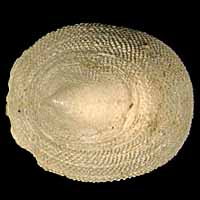|
< Previous family introduction |
|
|||||
 |
Order Cocculiniformia Families Cocculinidae, Pseudococculinidae, Cocculinellidae and Choristellidae
|
|||||
|
The order Cocculiniformia contains a radiation of molluscs, mainly small limpets, that live on organic substrates in the deep sea. The order is of world-wide distribution, with about 130 species divided into 10 families, but representatives of only four families are known from NSW. The families are united by a suite of anatomical characters, including unique radula features, the type and position of the gill, structure of the alimentary tract, and the organisation of the reproductive system. The family Cocculinidae consists of small, white limpets that live, world-wide, from 30 to more than 3700 m deep. They live on sunken, waterlogged wood, obtaining nourishment from the wood itself or from the associated bacteria. The periostracum incorporates spines which, in the case of the two NSW species, are useful in distinguishing the species. The family Pseudococculinidae also consists of small, white limpets that are known down to 5700 m. World-wide they live on wood, algal holdfasts and dead crab carapaces; the three NSW species live on waterlogged wood. The family Cocculinellidae consists of limpets that live and feed on fish bones. Their hells are small - only about 3 mm in length - and elongated. A bone sample illustrated by Marshall (1983) shows that the molluscs have excavated depressions in the bone, apparently remaining in a fixed position throughout life. Their elongate form may be an adaptation to life on long, narrow bones. Only one species is known from NSW. The Choristellidae contains species that have coiled shells, in contrast to the limpet-shaped shells of the rest of the order. They live in and feed on spent egg cases of sharks and rays. Placement in the order Cocculiniformia is based on similarity of anatomy, including radula, gills, and alimentary tract. One species is known from NSW. Except for the Choristellidae, animals of this order are simultaneous hermaphrodites i.e, each animal has both male and female reproductive organs functioning at the same time. Eggs are fertilised in the mantle cavity, where they may be retained for brooding, before release into the sea as free-swimming larvae. Larvae are apparently produced in large numbers, and are carried by currents until fortuitously falling upon their suitable substrate of wood, bone or egg case. The taxonomy and biology of animals of this order is fairly well studied. Marshall (1986) described the shells, radulae and external anatomy of 25 species from New Zealand and NSW, of which 22 were new. McLean (1992) reviewed the family Choristellidae worldwide, including the single species from NSW. There are seven species of the order known from NSW, placed in four families. Six of the seven species have been described since 1986, reflecting their infrequent availability. Most are known from only a few samples of each species obtained from wood, bone or egg cases accidentally dredged by trawlers or research vessels from depths of 100-800 m. Their abundance in the deep sea is unknown, but some species have been found in large numbers on the few samples of wood that have been brought up. The known distributions are fairly small, based mainly on deep water dredging in central NSW, but they are no doubt much more extensive. Three species occur in both New Zealand and central NSW, but may well occur on the sea floor between these two regions. Family references Marshall, B.A. 1986. Recent and Tertiary Cocculinidae and Pseudococculinidae (Mollusca: Gastropoda) from New Zealand and New South Wales. New Zealand Journal of Zoology 12: 505-546. McLean, J. 1992. Systematic review of the family Choristellidae (Archaeogastropoda: Lepetellacea) with descriptions of new species. The Veliger 15(4) 273-294. Coverage All species known from NSW are detailed here. Identification Notes Shells may be recognised as belonging in the order Cocculiniformia (except Choristellidae) by their limpet-like shape and deep-water habitat, but a knowledge of the substrate and the external anatomy of the animal is required for placement in a particular family. Shells of the Choristellidae are thin, fragile and coiled, with an open umbilicus with a spiral ridge internally.
|